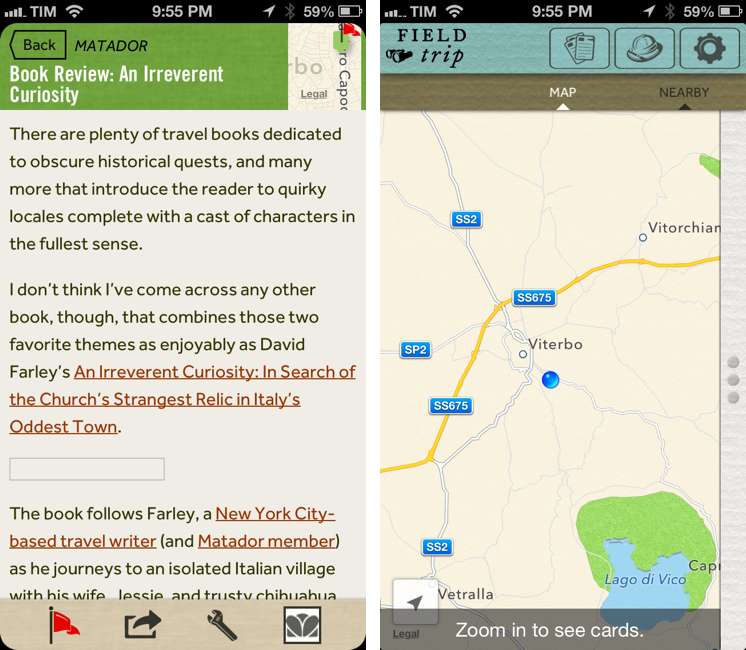Earlier today, Google released Field Trip for iPhone, a tour guide app to alert users through notifications of “cool, hidden, and unique things” that are nearby. Using your location, the app can provide notifications for “your interests” such as Food, Drinks & Fun, Museums, Deals, and more. The app uses various data providers, including their own Zagat, to provide information about places to the user.
Released on Android in the Fall of 2012, Field Trip can “speak” notifications using either a Bluetooth headset or the iPhone’s speaker. A cool thing about Field Trip, in fact, is that you have control over audio output in the Settings: you can choose whether the app should speak the name of an interesting place or also its description, or if you want to enable the app’s audio notifications when device is docked, connected via wired headset, or through a Bluetooth device. This part of the app is really well done. Field Trip can even detect while you’re driving (my guess is through GPS).
The interface and data availability leaves much to be desired. In terms of UI design, my personal taste doesn’t like the choices made by Google: there’s a strange mix of fonts, plus rounded and non-rounded flat buttons that make browsing Field Trip confusing. Furthermore, the app puts buttons to switch between views in the title bar rather than a bottom toolbar – something that is utterly confusing on iOS in my opinion.
There’s no mention of US-only features on Field Trip’s website or iTunes page, but the app didn’t find anything “cool, hidden, or unique” near me. For some reason, it only found a book review in the middle of Viterbo. Curious, I went to check out the location Field Trip pinpointed, and it was a book store. Of all the books available in modern history and sold by my town’s Fernandez book store, why did Field Trip’s data sources collaborate in a miracle of algorithms to deliver the review of “An Irreverent Curiosity” to me? But then again, why the book review, and not just the book itself? What is Google trying to tell me? Why Viterbo, of all places?
I think a passage of the aforementioned review is particularly apt for my experience with the app:
…an entertaining, endearing and, yes, educational mix of history, conspiracy, humor, and personal travelogue.
The book’s description is even better. I won’t paste it here because I don’t want those keywords on my site, but check it out at Amazon.
Viterbo isn’t the most exotic Italian town ever, but I can confirm that there are, in fact, cool and hidden things here. I wouldn’t bet on unique, but two out of three doesn’t sound like a bad deal to me. And in spite of the cool (exhibit A) and hidden things (exhibit B), Field Trip couldn’t recommend anything (I did activate the option to receive as many notifications as possible). This seems strange considering that a) Google’s own Maps app can certainly discover places thanks to its Pagine Gialle provider and b) for facts or things, solutions like Localscope show how sources like Wikipedia can provide information and data.
Last, there are some curious omissions or inconsistencies worth pointing out. Google recently released a Google Maps SDK for developers, but Field Trip uses Apple’s MapKit-powered maps. This seems like a lost opportunity to combine the embedded map view with the Google Maps app for navigation purposes. The app opens links in Chrome without asking the user about it, but there’s no support for x-callback-url to return to the app – something that Google does support with Chrome.
Google says they’re adding new places and “things” to Field Trip every day, and I like the idea in theory. I think it’s curious that some choices were made for this first release, and, admittedly, if it weren’t for Google I wouldn’t have tried the app. I believe the idea of audio notifications is great, but, alas, the app is empty for me.
Except for that book review.



